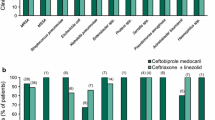Abstract
We aimed to prospectively evaluate the clinical and bacteriological effects of piperacillin in children with pneumonia. Twenty-eight patients (6 months to 5 years of age) with pneumonia were treated with piperacillin. In the same period, 95 strains of Haemophilus influenzae and 41 strains of Streptococcus pneumoniae were isolated in our department and the minimum inhibitory concentration (MIC) of piperacillin was determined. The clinical efficacy of piperacillin was excellent in 4 cases, good in 23, and fair in 1; the response rate was 96.4% (27/28). Among the isolates from our department, there were 4 strains (9.8%) of penicillin-susceptible S. pneumoniae (PSSP), 32 strains (78.0%) of penicillin-intermediate-resistant S. pneumoniae (PISP), and 5 strains (12.2%) of penicillin-resistant S. pneumoniae (PRSP). Against S. pneumoniae, the MIC50 and MIC90 for piperacillin were 0.5 µg/ml and 2 µg/ml, respectively. Panipenem showed the best results, followed by piperacillin, ampicillin, and flomoxef. Among the isolates from our department, there were 51 strains (53.7%) of β-lactamase-negative ampicillin-susceptible H. influenzae, 42 strains (44.2%) of β-lactamase-negative ampicillin-resistant H. influenzae, 1 strain (1.1%) of β-lactamase-positive ampicillin-resistant H. influenzae, and 1 strain (1.1%) of β-lactamase-positive amoxicillin-clavulanic acid-resistant H. influenzae. The MIC50 and MIC90 for piperacillin against H. influenzae were 0.0625 µg/ml and 0.125 µg/ml, respectively. Tazobactam/piperacillin and piperacillin showed the best results, followed by panipenem, ampicillin, and flomoxef. Piperacillin proved to be very useful for the treatment of pneumonia in children.
Similar content being viewed by others
References
InstitutionalAuthorNameClinical Evaluation Committee in Pediatrics of Japanese Society of Chemotherapy (2003) ArticleTitleJudgment criteria in clinical tests for antibacterial agents used in pediatrics Jpn J Chemother 51 144–51
National Committee for Clinical Laboratory Standards. Methods for dilution antimicrobial susceptibility tests for bacteria that grow aerobically: approved standards. Fifth edition. NCCLS document M100-S5. Wayne, PA: NCCLS; 2001
H Shishido H Sekiguchi M Ikeda I Kano S Takai (1977) ArticleTitleClinical studies on T-1220 in pediatric infections Jpn J Chemother 25 1141–55
F Sudo N Ishiwada T Hoshino C Fukasawa Y Inami H Hishiki et al. (2005) ArticleTitleClinical effects of piperacillin and tazobactam/piperacillin on Haemophilus influenzae lower respiratory tract infection in pediatric patients Kansenshogaku Zasshi 79 637–43 Occurrence Handle16248372
Y Morikawa M Kitazato J Mitsuyama S Mizunaga S Minami Y Watanabe (2004) ArticleTitleIn vitro activities of piperacillin against β-lactamase-negative ampicillin-resistant Haemophilus influenzae Antimicrob Agents Chemother 48 1229–34 Occurrence Handle15047524 Occurrence Handle10.1128/AAC.48.4.1229-1234.2004 Occurrence Handle1:CAS:528:DC%2BD2cXjtVKqsr8%3D
WA Craig (1998) ArticleTitlePharmacokinetic/Pharmacodynamic parameters: rationale for antibacterial dosing of mice and men Clin Infect Dis 26 1–12 Occurrence Handle9455502 Occurrence Handle1:CAS:528:DyaK1cXltVaqtw%3D%3D
GL Drusano WA Craig (1997) ArticleTitleRelevance of pharmacokinetics and pharmacodynamics in the selection of antibiotics for respiratory tract infections J Chemother 9 IssueIDSuppl 3 38–44 Occurrence Handle9248979 Occurrence Handle1:CAS:528:DyaK2sXlt1Ghs7s%3D
G Woodnutt V Berry (1999) ArticleTitleTwo pharmacodynamic models for assessing the efficacy of amoxicillin-clavulanate against experimental respiratory tract infections caused by strains of Streptococcus pneumoniae Antimicrob Agents Chemother 43 29–34 Occurrence Handle9869561 Occurrence Handle1:CAS:528:DyaK1MXpvFGgsA%3D%3D
PC Appelbaum A Bhamjee JN Scragg AF Hallett AJ Bowen RC Cooper (1977) ArticleTitle Streptococcus pneumoniae resistant to penicillin and chloramphenicol Lancet II 995–7 Occurrence Handle10.1016/S0140-6736(77)92892-6
D Felmingham RR Reinert Y Hirakata A Rodloff (2002) ArticleTitleIncreasing prevalence of antimicrobial resistance among isolates of Streptococcus pneumoniae from the PROTEKT surveillance study, and comparative in vitro activity of the ketolide, telithromycin J Antimicrob Chemother 50 25–37 Occurrence Handle12239226 Occurrence Handle10.1093/jac/dkf089 Occurrence Handle1:CAS:528:DC%2BD38XnvFCmtrg%3D
W Khan S Ross W Rodriguez G Controni AK Saz (1974) ArticleTitle Haemophilus influenzae type B resistant to ampicillin JAMA 229 298–301 Occurrence Handle4546094 Occurrence Handle10.1001/jama.229.3.298 Occurrence Handle1:STN:280:CSuB28zmvFQ%3D
S Uehara I Terashima A Nakamura T Kurosaki N Sugaya Y Okimoto et al. (1985) ArticleTitleThe role of Haemophilus influenzae in lower respiratory infections in childhood Acta Pediatr Jpn 27 94–101
SM Markowitz (1980) ArticleTitleIsolation of an ampicillin-resistant, non-beta-lactamase-producing strain of Haemophilus influenzae Antimicrob Agents Chemother 17 80–3 Occurrence Handle6965443 Occurrence Handle1:CAS:528:DyaL3cXhtVCmtLc%3D
D Hoban D Felmingham (2002) ArticleTitleThe PROTEKT surveillance study: antimicrobial susceptibility of Haemophilus influenzae and Moraxella catarrhalis from community-acquired respiratory tract infections J Antimicrob Chemother 50 49–59 Occurrence Handle12239228 Occurrence Handle1:CAS:528:DC%2BD38XnvFCmtrY%3D
D Guillemot C Carbon B Balkau P Geslin H Lecoeur F Vauzelle-Kervroedan et al. (1998) ArticleTitleLow dosage and long treatment duration of β-lactam: risk factors for carriage of penicillin-resistant Streptococcus pneumoniae JAMA 279 365–70 Occurrence Handle9459469 Occurrence Handle10.1001/jama.279.5.365 Occurrence Handle1:CAS:528:DyaK1cXhtVGgtrY%3D
MR Jacobs S Bajaksouzian A Zilles G Lin GA Pankuch PC Appelbaum (1999) ArticleTitleSusceptibilities of Streptococcus pneumoniae and Haemophilus influenzae to ten oral antimicrobial agents based on pharmacodynamic parameters: 1997 U.S. Surveillance Study Antimicrob Agents Chemother 43 1901–8 Occurrence Handle10428910 Occurrence Handle1:CAS:528:DyaK1MXltVeks7o%3D
ME Jones JA Karlowsky R Blosser-Middleton IA Critchley C Thornsberry DF Sahm (2002) ArticleTitleApparent plateau in β-lactamase production among clinical isolates of Haemophilus influenzae and Moraxella catarrhalis in the United States: results from the LIBRA Surveillance initiative Int J Antimicrob Agents 19 119–23 Occurrence Handle11850164 Occurrence Handle10.1016/S0924-8579(01)00480-0 Occurrence Handle1:CAS:528:DC%2BD38Xht1ajsLg%3D
Author information
Authors and Affiliations
Corresponding author
About this article
Cite this article
Aoki, M., Fukao, T., Kaneko, H. et al. Clinical and bacteriological evaluation of the efficacy of piperacillin in children with pneumonia. J Infect Chemother 13, 224–229 (2007). https://doi.org/10.1007/s10156-007-0529-4
Received:
Accepted:
Published:
Issue Date:
DOI: https://doi.org/10.1007/s10156-007-0529-4



